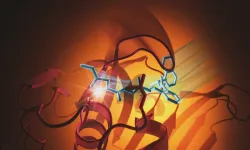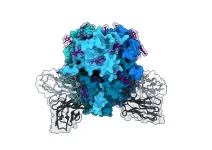(Press-News.org) Bioactive compounds present mostly in fruit and vegetables perform different bodily functions relating to health and well-being. Their effects are considered antioxidant, antidiabetic, antiaging and anticancer, among others.
Many studies are looking for ways to optimize absorption of bioactive compounds by the organism and increase their bioavailability – the proportion that enters the bloodstream after absorption. One way is to coat the compounds with another material and package them on the nanometric scale (a nanometer is a billionth of a meter). Nanoencapsulation, as this technique is known, assures slow release of the compounds so that they take longer to digest and can survive the attacks of bacteria in the gut microbiome.
An investigation conducted by a duo of researchers at the University of São Paulo’s School of Pharmaceutical Sciences (FCF-USP) in Brazil is one of these studies. Working at the school’s Department of Food Science and Experimental Nutrition, they have produced several articles on the subject – the latest of which, published in the International Journal of Biological Macromolecules, is a review of the literature on pectin-based nanoencapsulation plus a description of a novel technology developed under the aegis of the Food Research Center (FoRC), a Research, Innovation and Dissemination Center (RIDC) supported by FAPESP.
“We used pectin extracted from residues of citrus fruit albedo and peel, with a degree of purity permitting human ingestion and excluding any kind of hazardous chemical,” said João Paulo Fabi, one of the authors and a professor at FCF-USP. Albedo is the layer of white spongy material inside the peel of oranges and lemons, for example.
“In addition to our review of the literature, we describe a novel technology for nanoencapsulation of bioactive compounds using pectin. This entails producing a pectin-lysozyme complex as a protective outer layer for a highly sensitive bioactive compound called anthocyanin,” he explained, adding that lysozyme is “a safely edible substance obtained from egg white and used to enhance the stability of the end-product”.
Anthocyanins are water-soluble pigments belonging to the flavonoid family. They are phenolic compounds found in all plants and responsible for the shades of red, blue and purple seen in flowers, fruit, leaves, stalks and roots.
The authors say their methodology can be used to encapsulate other water-soluble bioactive compounds. “We tested anthocyanin because of its challenging sensitivity to many factors, such as light, temperature, pH and gut bacteria,” said Thiécla Katiane Osvaldt Rosales, the other author. She is currently a postdoctoral researcher at the Nuclear and Energy Research Institute (IPEN).
Besides FoRC, FAPESP also funded the research via support for two other projects (19/11816-8 and 12/23970-2).
Advantages of methodology
According to the researchers, the main advantage of their methodology is that no other compounds are added apart from pectin, lysozyme and anthocyanin. “We used three compounds from sources in nature and mixed them in the laboratory to form a new product, without adding salts, ligands or anything potentially toxic. Furthermore, the nanoparticles are not too small. Very tiny nanoparticles can penetrate barriers and cell membranes, entering the DNA and having toxic effects. The size we obtained is safe,” Fabi said.
Rosales outlined the process they developed to produce the nanoparticles. “Pectin and lysozyme are heated separately. The increase in temperature partly alters their structure, and they interact better when heated. They are then rapidly cooled to reach a temperature not harmful to anthocyanin, which is sensitive and fairly unstable. The three substances are blended in an aqueous suspension and agitated for an hour. The result is encapsulated anthocyanin. The suspension is then filtered to separate the non-encapsulated contents,” she said.
Special care is taken with factors such as temperature and pH. “We tested the parameters for the purpose of optimization, especially pH. If pH is too high, the anthocyanin breaks down. It can’t be too low, either. We found a pH of 5 to be optimal for interaction between the molecules,” she explained. “We also tested the duration and intensity of the agitation. We made a point of managing all the details, however minor, because they make a difference in terms of forming stable particles. We’ve applied for a patent on the methodology.”
Results
Finally, the encapsulation was tested for efficacy in a digestion system simulated in the laboratory to mimic the gastric and intestinal phases. “The result was that part of the anthocyanin was released during the digestive process, at the end of gastric digestion, and part remained in the nanostructure, with the possibility of release of this remainder in the gut or absorption together with the nanostructure. We believe this was a good outcome. Partial and gradual release suggests absorption of the compound starts before it enters the gut, with the nanoencapsulated remainder probably being released in the gut or fully absorbed with less structural alteration,” Rosales said.
The next step will be animal testing. “We tested the method in vitro and obtained results indicating that the nanoparticles are safe for consumption. We have evidence that cells can absorb them in a non-toxic manner and that the pectin protects the anthocyanin and its properties. We now have to test it in animals, observing the process of oral ingestion, absorption of the anthocyanin using specific markers for absorption, and the route followed in the organism. It’s important to verify the extent of absorption and the biological destination,” she said.
The nanoparticles are mainly intended for use as a food supplement. “They can be added to food and dietary supplements, but industrial mass production would be necessary to include them in a supplement,” Fabi said.
It is worth noting that the method does not require expensive equipment or procedures. “In addition, the material used for the nanocapsules, which comes from byproducts of citrus peel, would make the cost even lower for manufacturers. The pectin we used in our study is available commercially and is used by the food industry, mostly for gel formation in jam or as a thickener,” Rosales said.
About São Paulo Research Foundation (FAPESP)
The São Paulo Research Foundation (FAPESP) is a public institution with the mission of supporting scientific research in all fields of knowledge by awarding scholarships, fellowships and grants to investigators linked with higher education and research institutions in the State of São Paulo, Brazil. FAPESP is aware that the very best research can only be done by working with the best researchers internationally. Therefore, it has established partnerships with funding agencies, higher education, private companies, and research organizations in other countries known for the quality of their research and has been encouraging scientists funded by its grants to further develop their international collaboration. You can learn more about FAPESP at www.fapesp.br/en and visit FAPESP news agency at www.agencia.fapesp.br/en to keep updated with the latest scientific breakthroughs FAPESP helps achieve through its many programs, awards and research centers. You may also subscribe to FAPESP news agency at http://agencia.fapesp.br/subscribe.
END
Technology to protect bioactive compounds from food during digestion
Scientists at a FAPESP-supported research center combined substances extracted from fruit residues and egg white to package nanoparticles of anthocyanin, a plant pigment with antioxidant action.
2023-03-28
ELSE PRESS RELEASES FROM THIS DATE:
New drug combination holds unusually positive results for HPV-negative patients with advanced head and neck cancer
2023-03-28
WASHINGTON (March 28, 2023)— A new combination drug treatment showed promising results in patients with pan-refractory, recurrent/metastatic head and neck cancer, according to a study published today in the Journal of Clinical Oncology.
Head and neck cancer is a deadly form of cancer that arises in the lining of the mouth and throat. Worldwide more than 700,000 people were diagnosed with head and neck cancer in 2021. The disease is caused by the human papillomavirus (HPV) or environmental carcinogens, including the regular use of tobacco or alcohol. When the cancer comes back after curative ...
NASA wallops supports second rocket lab electron launch
2023-03-28
NASA’s Wallops Flight Facility supported the successful launch of a Rocket Lab Electron rocket at 6:39 p.m. EDT, Thursday, March 16, from Virginia’s Mid-Atlantic Regional Spaceport on Wallops Island, Virginia.
The mission, named “Stronger Together,” carried two, 100-kilogram commercial satellites to low-Earth orbit for Capella Space.
“I’m extremely proud of the NASA team that helped ensure a safe and successful launch operation today,” said ...
Researchers find new molecule that shows promise in slowing SARS-CoV-2
2023-03-28
Researchers have designed a molecule that slows the effects of one of SARS-CoV-2's more dangerous components – an enzyme called a protease that cuts off the immune system's communications and helps the virus replicate.
While much more needs to happen to develop a drug, scientists can begin to imagine what that drug could look like – thanks to new images of the molecule bound to the protease.
“We have been searching for an effective molecule like this one for a while,” said Suman Pokhrel, a Stanford University graduate student in chemical and systems biology and one of the paper’s lead authors. “It is ...
Rural educators find solutions to support multilingual learners
2023-03-28
A new study found a professional development program helped teachers in a rural school district in the Southeast to collaborate and identify innovative solutions to serve multilingual learners, or students learning English as a second language.
The study, published in the Journal of Research in Rural Education, suggests professional development can help prepare teachers in rural districts that have fewer resources and a growing need to support multilingual learners.
“Professional development is essential in rural communities, where you might not have resources for specialists like a literacy coach, bilingual school psychologist, or bilingual family engagement specialist,” ...
Retinal scans: A non-invasive, inexpensive method to track human aging
2023-03-28
Buck Institute professor Pankaj Kapahi thinks the eye is a window to aging. His lab, in collaboration with Google Health and Zuckerberg San Francisco General Hospital, has shown how imaging of the fundus, the blood vessel-rich tissue in the retina, can be used to track human aging, in a way that is noninvasive, less expensive and more accurate than other aging clocks that are currently available. Publishing in eLife, researchers also did a genome-wide association study (GWAS) to establish the genetic basis for such a clock, which they call eyeAge.
“This type of imaging could be really ...
New additives could turn concrete into an effective carbon sink
2023-03-28
CAMBRIDGE, MA -- Despite the many advantages of concrete as a modern construction material, including its high strength, low cost, and ease of manufacture, its production currently accounts for approximately 8 percent of global carbon dioxide emissions.
Recent discoveries by a team at MIT have revealed that introducing new materials into existing concrete manufacturing processes could significantly reduce this carbon footprint, without altering concrete’s bulk mechanical properties.
The findings are published today in the ...
Fluorescent visualization and evaluation of NPC1L1-mediated cholesterol absorption at the levels of endocytic vesicles
2023-03-28
Excessive cholesterol absorption from intestinal lumen contributes to the pathogenesis of hypercholesterolemia, which is a well-established risk factor for atherosclerotic cardiovascular disease. The absorption of intestinal cholesterol is primarily mediated by Niemann-Pick C1-like 1 (NPC1L1) protein, which is responsible for about 70% cholesterol absorption. NPC1L1-deficient mice are resistant to diet-induced hypercholesterolemia, which provides a compelling strategy for intervention the related diseases through inhibiting NPC1L1 expression or activity.
NPC1L1 protein is expressed in the brush border membrane of small intestine. The protein is extensively N-glycosylated ...
Biden-Harris Administration announces recipients of the Enrico Fermi Award
2023-03-28
Today, the Biden-Harris Administration announced Darleane C. Hoffman and Gabor A. Somorjai as recipients of the Enrico Fermi Presidential Award, one of the oldest and most prestigious science and technology honors bestowed by the U.S. government.
“Dr. Hoffman and Dr. Somorjai’s work to open the frontiers of radiochemistry and surface chemistry helped change what was possible, and advanced efforts to tackle some of the world’s greatest challenges,” said Assistant to the President and Director of the White House Office of Science and Technology Policy Arati Prabhakar. “They are world-class ...
We've learned a lot from lymphocytic choriomeningitis virus—now the time has come to fight it
2023-03-28
Key findings:
There are no vaccines or therapies available for lymphocytic choriomeningitis virus (LCMV) infection. This pathogen spreads easily and is extremely common in people worldwide.
Infection with LCMV can cause birth defects in developing fetuses, and severe illness and even death in the immuncompromised.
New findings from La Jolla Institute for Immunology (LJI) scientists show how an engineered antibody can target LCMV and neutralize the virus. They found this antibody has the potential to both prevent infection and treat an already established infection.
With this better understanding of LCMV's weak spots, scientists can move forward ...
RSV hospitalizations spiked unusually high in late 2021, study finds
2023-03-28
The COVID-19 pandemic posed an immense challenge on the health care industry in 2020 and 2021. While hospitals were inundated with COVID-19 cases, other illnesses such as respiratory syncytial virus (RSV) saw a decrease in hospital visits, particularly in the fourth quarter of 2020 and the first quarter of 2021.
A Texas A&M University School of Public Health study recently published in the journal Frontiers found that while there were an unusually low number of hospitalizations in 2020, there was an unusual peak in the third quarter of 2021, when hospital admissions for RSV were approximately twice ...
LAST 30 PRESS RELEASES:
Climate extremes triggered rare coral disease and mass mortality on the Great Barrier Reef
Direct observation reveals “two-in-one” roles of plasma turbulence
Humans rank between meerkats and beavers in monogamy ‘league table’
US fossil reveals early mass-burial event and ancient microbial attack
Sedative choice could improve outcomes for breathing tube patients
New superconducting thin film for quantum computer chips
Simulations reveal protein "dynamin" constricts cell membranes by loosening its grip
Nearly 1 in 5 UK emergency department patients cared for in corridors/waiting rooms
Heavy energy drink intake may pose serious stroke risk, doctors warn
Violence against women and children among top health threats: New global study reveals disease burden far larger than previously estimated
Predicting who is at risk of developing type 1 diabetes, as new drugs now available
New gene-mapping method unlocks hidden drivers of cancer
Ocean current and seabed shape influence warm water circulation under ice shelves
Call to increase funding for ‘invisible’ Deaf victim-survivors of domestic abuse
University of Maryland School of Medicine names distinguished scientist and academic leader Gerald M. Wilson, PhD, as Chair of the Department of Biochemistry and Molecular Biology
Receptors in mammary glands make livestock and humans inviting hosts for avian flu
Icy hot plasmas
Treating adults with autism: Maryland Clinical Center offers national blueprint for care after pediatric transition
University of Phoenix College of Doctoral Studies releases white paper on reclaiming control to build workforce resilience
NCCN Summit seeks to improve care for veterans and first responders with cancer from line-of-duty exposure
ERC Consolidator Grant for soft robotics researcher
Dual-action arts and wellbeing program transforms dementia care
The global plastic waste trade contributes to coastal litter in importing countries, study shows
UT Dallas partners with Tech Mahindra on AI innovation
Blinking less could signal the brain is working harder to listen, Concordia study shows
Male bonobos track females’ reproductive cycle to maximize mating success
New report outlines science priorities for human Mars exploration
Want to curb cannabis-related crashes? Don’t forget older adults, study finds
Expectant management vs medication for patent ductus arteriosus in preterm infants
Pew funds 7 new biomedical research collaborations
[Press-News.org] Technology to protect bioactive compounds from food during digestionScientists at a FAPESP-supported research center combined substances extracted from fruit residues and egg white to package nanoparticles of anthocyanin, a plant pigment with antioxidant action.


